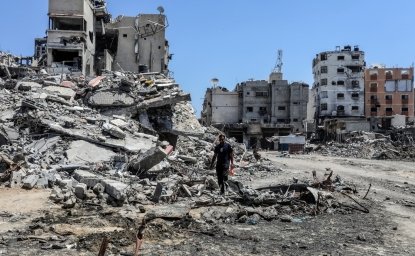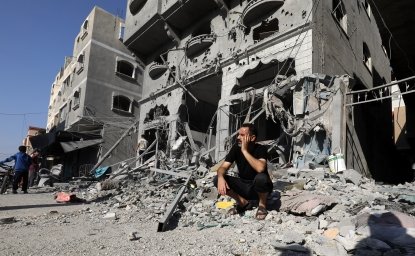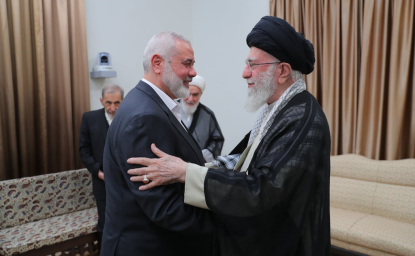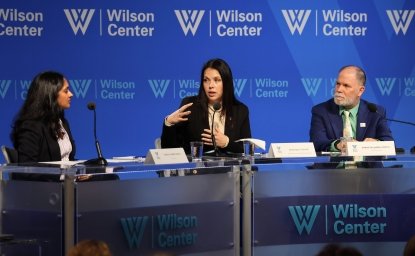By Cameron Glenn
Government
Iran and Saudi Arabia both claim to be model states based on Islam. But Iran is a theocracy with democratic elements, and Saudi Arabia is a hereditary monarchy. Iran’s political system is based on Shiism, while Saudi Arabia has strong ties to Wahhabism, a conservative branch of Sunni Islam.
 Iran
Iran
 Saudi Arabia
Saudi Arabia
The Constitution
Article 2
The Islamic Republic is a system based on belief in:
1.the One God (as stated in the phrase “There is no god except Allah”), His exclusive sovereignty and the right to legislate, and the necessity of submission to His commands;
2.Divine revelation and its fundamental role in setting forth the laws”
Preamble
“In the view of Islam, government does not derive from the interests of a class, nor does it serve the domination of an individual or a group. It represents rather the crystallization of the political ideal of a people who bear a common faith and common outlook… Our nation, in the course of its revolutionary developments, has cleansed itself of the dust and impurities that accumulated during the taghuti [idol-worshipping] past and purged itself of foreign ideological influences, returning to authentic intellectual standpoints and world-view of Islam. It now intends to establish an ideal and model society on the basis of Islamic norms.”
The Basic Law of Governance
Chapter 1, Article 1
The Kingdom of Saudi Arabia is a sovereign Arab Islamic State. Its religion is Islam. Its constitution is Almighty God's Book, The Holy Qur'an, and the Sunna (Traditions) of the Prophet (PBUH).
Chapter 2, article 7
Government in the Kingdom of Saudi Arabia derives its authority from the Book of God and the Sunna of the Prophet (PBUH), which are the ultimate sources of reference for this Law and the other laws of the State.
Chapter 2, Article 8
Governance in the Kingdom of Saudi Arabia is based on justice, shura (consultation) and equality according to Islamic Sharia.
King Fahd, in a speech announcing the 1992 Basic Law
“The Saudi State has become a distinguished model of politics and government in modern political history.”
“The relationship between citizens and state officials is founded on solid and deep-rooted traditions, compassion, mutual respect and loyalty stemming from the sincere and firm convictions in the hearts of this country's people generation. There is no difference between the ruler and the ruled. They are equal before the law of God, and they are all equal in their love of this homeland and in their eagerness to maintain its safety, unity, pride and progress.”
Iran: The constitution lays out an idyllic vision of “an ideal and model society” based on Islam. The Islamic Republic is strongly anti-monarchical, and its political system contains a blend of democratic and theocratic elements. Its constitution draws upon French and Belgian law, while stipulating that all laws be compatible with Sharia. The government has executive, legislative, and judicial branches, but also a parallel set of Islamic institutions. Iran holds elections for the president, parliament, and Assembly of Experts (which selects the supreme leader). But all candidates must be vetted by the 12-member Guardian Council, overseen by the supreme leader.
Iran's political system is based on Shiism. Shiites make up around 10 percent of the world's Muslims, but 90 percent of Iranians are Shiites. The split between Sunnis and Shiites dates back to the Prophet Mohammad's death in the seventh century. Shiites believed that Ali, the Prophet's son-in-law and cousin, should be his immediate successor. But Sunnis believed that the Muslim community could select a new leader without blood ties to the Prophet.
Iranians predominantly practice "Twelver" Shiism. Twelver Shiites believe that the twelfth imam, who disappeared in 874AD, will one day return as the Mahdi, or promised one. In Twelver Shiism, clerics can substitute for the Mahdi’s authority, and the faithful are obliged to follow their religious rulings.
Although the Shiite clergy were historically independent from government, Iran’s theocracy seized control of the “sacred” after the 1979 revolution and co-opted the clerical establishment. Iran’s theocratic regime has deprived the entire clerical class of its autonomy, but also made it rich and powerful. Khamenei, for example, reportedly controls a multi-billion dollar financial empire.
Saudi Arabia: Like Iran’s constitution, Saudi Arabia’s Basic Law frames the political system as an ideal Islamic state. In 1992, King Fahd described Saudi Arabia as a “distinguished model of politics.”
Saudi Arabia is a monarchy. Extensive powers are allocated to the king, who must be a descendent of the first Saudi monarch, Abdul Aziz Ibn Saud. Political parties are banned, and the only public elections are for municipal councils.
The royal family has strong links to Wahhabism, a conservative branch of Sunni Islam. The relationship dates back to the 18th century. Mohammad Ibn Abd al Wahhab, founder of the Wahhabi movement, sought protection from Mohammad Ibn Saud and his tribe in 1744. In the early 20th century, Bedouin followers of Wahhabism, known as the Ikhwan, were instrumental in aiding Abdul Aziz Ibn Saud in his military campaign to unify much of the Arabian Peninsula.
In his teachings, Wahhab denounced popular Islamic practices, particularly those associated with Sufism, and emphasized the concept of tawhid, or oneness of God. He drew upon the teachings of 14th century scholar Ibn Taymiyya, who called for a return to the earliest forms of Islam. Wahhabis hold conservative views on gender relations, minority rights, and personal freedoms. They denounce pilgrimages to tombs – a common practice in Shiism – as polytheistic.
Saudi laws and regulations are rooted in Wahhabi principles, but the Saud family holds ultimate authority in the kingdom. Unlike in Iran, clerics do not play a formal role in government. But they have been incorporated into the political establishment through the Senior Council of Ulama, the kingdom’s highest religious body. The council advises the king and provides endorsements for state policies. In 2009, King Abdullah extended membership for the first time to non-Wahhabi scholars.
Laws and Courts
Iran and Saudi Arabia base their court systems on Islam. They both emphasize the right of every citizen to seek justice through the courts.
Both have also been criticized for human rights violations. According to the U.S. State Department, both countries restrict civil liberties and engage in arbitrary arrests and detentions. Additionally, Iran and Saudi Arabia together accounted for more than 62 percent of the 607 executions recorded by Amnesty International in 20 countries in 2014. Both are on track in 2015 to have their highest execution rates in two decades. Iran and Saudi Arabia are among a handful of countries that issue the death penalty for crimes the perpetrators committed as minors.
Iran
Saudi Arabia
The Constitution
“Legislation setting forth regulations for the administration of society will revolve around the Qur'an and the Sunnah. Accordingly, the exercise of meticulous and earnest supervision by just, pious, and committed scholars of Islam (al-fuqaha' al-'udul) is an absolute necessity.”
“The judiciary is of vital importance in safeguarding the rights of the people in accordance with the line followed by the Islamic movement, and the prevention of deviations within the Islamic nation. Provision has therefore been made for the creation of a judicial system based on Islamic justice and operated by just judges with meticulous knowledge of the Islamic laws.
Article 32
“No one may be arrested except by the order and in accordance with the procedure laid down by law…
Article 34
“It is the indisputable right of every citizen to seek justice by recourse to competent courts. All citizens have right of access to such courts, and no one can be barred from courts to which he has a legal right of recourse.
Article 35
“Both parties to a lawsuit have the right in all courts of law to select an attorney, and if they are unable to do so, arrangements must be made to provide them with legal counsel.”
The Basic Law of Governance
Chapter 6, Article 48
The Courts shall apply rules of the Islamic Sharia in cases that are brought before them, according to the Holy Qur'an and the Sunna, and according to laws which are decreed by the ruler in agreement with the Holy Qur'an and the Sunna.
Chapter 6, Article 55
The King shall rule the nation according to the Sharia. He shall also supervise the implementation of the Sharia, the general policy of the State, and the defense and protection of the country.
Chapter 5, Article 26
The State shall protect human rights in accordance with the Sharia.
Chapter 6, Article 46
The Judiciary is an independent authority. The decisions of judges shall not be subject to any authority other than the authority of the Islamic Sharia.
Chapter 6, Article 47:
All people, either citizens or residents in the Kingdom, are entitled to file suit on an equal basis. The Law shall specify procedures for this purpose.
Iran: The legal system includes many layers of civil, criminal and military courts. But it also has two sets of tribunals outside of the judiciary, the Revolutionary Courts and the Special Court for the Clergy. The latter has been used as a political tool to silence clerics who urge reform or challenge the regime.
Amputation, flogging and stoning to death are all legal according to Iran’s penal code. The code’s latest iteration, which entered into force in 2013, “now omits references to apostasy, witchcraft and heresy, but continues to allow for juvenile executions,” according to a U.N. report.
Iran’s most significant human rights problems include restrictions on civil liberties, arbitrary detentions, and torture, according to the U.S. State Department.
Iran ranks second in the world for executions, behind China. The death penalty applies to a wide range of crimes, including drug-related offenses, adultery, rape, sodomy, and insulting the Prophet Mohammad. Iran has seen a sharp rise in executions during the past few years. The government announced 289 executions in 2014, but there may have been hundreds more that were not formally acknowledged, according to Amnesty International. More than 800 people were executed between January and October 2015, putting Iran on track to have its highest execution rate in 25 years.
Saudi Arabia: The king acts as the head of the legal system and the final court of appeals. The High Court is the highest judicial authority in the kingdom.
The kingdom has three types of courts:
1) Sharia courts, which are the largest network of courts and hear the most cases
2) The Board of Grievances, which manages cases that involve the government
3) Committees in government ministries that address specific issues, such as labor disputes
Courts are required to issue rulings in accordance with Sharia. But Saudi Arabia does not have a formal penal code, so judges have flexibility to issue a wide range of convictions on charges such as “breaking allegiance with the ruler,” according to Human Rights Watch. Lashing, stoning, and amputations have been doled out as punishments.
Saudi Arabia restricts the rights of women, children, and non-citizens. Violations of due process, arbitrary arrests, and torture are common. Suspects are sometimes held for months or even years without facing trial. Saudi authorities have imprisoned human rights activists and political dissidents for peaceful activities.
Saudi Arabia ranks third in the world for executions. Less than half of death penalty cases are for murder, with the rest for crimes such as non-violent drug offenses and sorcery. At least 90 people were executed in 2014, and 151 were executed between January and November 2015 – the highest recorded figure in two decades.
International Relations
Both Iran and Saudi Arabia have sought to export their brands of Islam throughout the Muslim world. The two countries are vying for regional dominance by backing rival armed groups across the Middle East and South Asia.
 Iran
Iran
 Saudi Arabia
Saudi Arabia
Preamble to the Constitution
“With due attention to the Islamic content of the Iranian Revolution…the Constitution provides the necessary basis for ensuring the continuation of the Revolution at home and abroad. In particular, in the development of international relations, the Constitution will strive with other Islamic and popular movements to prepare the way for the formation of a single world community…and to assure the continuation of the struggle for the liberation of all deprived and oppressed peoples in the world.’”
Supreme Leader Ayatollah Ali Khamenei, in a speech on Nov. 2, 2015
“In the Constitution, Islam sets the criterion for foreign policy. Therefore, taking a stance vis-à-vis different countries and issues must lie within a religious framework.”
The Basic Law of Governance
Chapter 5, Article 23
The State shall protect the Islamic Creed, apply the Sharia, encourage good and discourage evil, and undertake its duty regarding the Propagation of Islam (Da'wa).
Iran: In the revolution’s early days, Iran sought to export its revolutionary ideology to both Sunnis and Shiites. “We shall export our revolution to the whole world,” Ayatollah Ruhollah Khomeini pledged. “Until the cry ‘there is no god but God’ resounds over the whole world, there will be struggle.”
The theocracy has actually had little success in exporting its Islamic revolution. Tehran funds the activities of clerics trained in the holy city of Qom and promotes its brand of Islam in Shiite communities across the world. But the strength of Iran’s soft power is debatable. After the devastating war with Iraq from 1980-1988, Tehran scaled back efforts to export its revolution.
Iran has had much more success assisting armed organizations that share its goals and values. It has cultivated spheres of influence in Shiite communities, particularly in Iraq and Afghanistan, and aided Palestinian Islamic groups Hamas and Islamic Jihad and Hezbollah in Lebanon. Iran reportedly sends Hezbollah between $100 million and $200 million per year, and has sent Hamas as much as $300 million per year, according to the Congressional Research Service. But precise figures are not known.
The goal of these relationships, however, has not been to gain territory. Iran’s only territorial disputes are with the United Arab Emirates over three small Gulf islands.
Saudi Arabia: The kingdom did little to export Wahhabism beyond its borders during its first few decades of existence. But in 1979, Saudi leaders felt their dominance in the Islamic world challenged by the Iranian revolution, which provided an alternative model of Islamic governance.
Since the 1980s, Saudi Arabia has reportedly spent at least $100 billion exporting Wahhabism to Muslim countries around the world through missionaries, building mosques and schools, media outreach, and other activities. The kingdom sent nearly $4 billion in aid to the mujahideen in Afghanistan in the 1980s, according to the Council on Foreign Relations. Loosely monitored Saudi-based charities have reportedly funded Sunni militant groups such as al Qaeda, the Taliban, and Hamas.
Saudi leaders have been criticized for their links to hardline Wahhabi doctrine, which has been adopted by extremist groups. These groups have also become a domestic threat. ISIS claimed responsibility for a series of attacks on Shiite mosques in Saudi Arabia May, August, and October 2015.
In 2014, the late King Abdullah put pressure on top clergy to denounce militant groups like ISIS and al Qaeda. In an effort to contain extremist currents, the government has promoted moderate clergy to key positions and even opened up the country’s top clerical council to non-Wahhabis.
This piece is part of a four-part series on Iran and Saudi Arabia.
- Part 1: Islam's Arch Rivals
- Part 2: Government & Ideology
- Part 3: Leadership
- Part 4: Women & Minorities
Photo credits: Hezbollah logo via Wikimedia Commons
Cameron Glenn is assistant editor of "The Islamists" and a senior program assistant at the U.S. Institute of Peace.
Author

The Islamists
Learn more about Hamas and how it relates to similarly aligned organizations throughout the region. Read more

Explore More
Browse Insights & Analysis
Israel Escalates Attacks in Gaza: What’s Next?

Israel Expands Operations on Multiple Fronts: Perspectives on the Conflict

